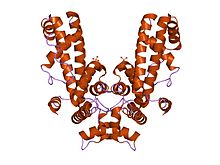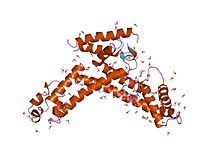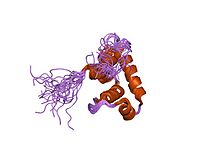Sigma factor
| Sigma70 region 1.1 | |||||||||
|---|---|---|---|---|---|---|---|---|---|
| Identifiers | |||||||||
| Symbol | Sigma70_r1_1 | ||||||||
| Pfam | PF03979 | ||||||||
| InterPro | IPR007127 | ||||||||
|
|||||||||
| Available protein structures: | |
|---|---|
| Pfam | structures |
| PDB | RCSB PDB; PDBe; PDBj |
| PDBsum | structure summary |
| Sigma70 region 1.2 | |||||||||
|---|---|---|---|---|---|---|---|---|---|

Crystal structure of Thermus aquaticus RNA polymerase sigma subunit fragment containing regions 1.2 to 3.1
|
|||||||||
| Identifiers | |||||||||
| Symbol | Sigma70_r1_2 | ||||||||
| Pfam | PF00140 | ||||||||
| InterPro | IPR009042 | ||||||||
| PROSITE | PDOC00592 | ||||||||
| SCOP | 1sig | ||||||||
| SUPERFAMILY | 1sig | ||||||||
|
|||||||||
| Available protein structures: | |
|---|---|
| Pfam | structures |
| PDB | RCSB PDB; PDBe; PDBj |
| PDBsum | structure summary |
| Sigma70 region 2 | |||||||||
|---|---|---|---|---|---|---|---|---|---|

Crystal structure of a sigma70 subunit fragment from Escherichia coli RNA polymerase
|
|||||||||
| Identifiers | |||||||||
| Symbol | Sigma70_r2 | ||||||||
| Pfam | PF04542 | ||||||||
| Pfam clan | CL0123 | ||||||||
| InterPro | IPR007627 | ||||||||
| PROSITE | PDOC00592 | ||||||||
| SCOP | 1sig | ||||||||
| SUPERFAMILY | 1sig | ||||||||
|
|||||||||
| Available protein structures: | |
|---|---|
| Pfam | structures |
| PDB | RCSB PDB; PDBe; PDBj |
| PDBsum | structure summary |
| Sigma70 region 3 | |||||||||
|---|---|---|---|---|---|---|---|---|---|

Solution structure of sigma70 region 3 from Thermotoga maritima
|
|||||||||
| Identifiers | |||||||||
| Symbol | Sigma70_r3 | ||||||||
| Pfam | PF04539 | ||||||||
| Pfam clan | CL0123 | ||||||||
| InterPro | IPR007624 | ||||||||
| SCOP | 1ku2 | ||||||||
| SUPERFAMILY | 1ku2 | ||||||||
|
|||||||||
| Available protein structures: | |
|---|---|
| Pfam | structures |
| PDB | RCSB PDB; PDBe; PDBj |
| PDBsum | structure summary |
| Sigma70 region 4 | |||||||||
|---|---|---|---|---|---|---|---|---|---|

Solution structure of sigma70 region 4 from Thermotoga maritima
|
|||||||||
| Identifiers | |||||||||
| Symbol | Sigma70_r4 | ||||||||
| Pfam | PF04545 | ||||||||
| Pfam clan | CL0123 | ||||||||
| InterPro | IPR007630 | ||||||||
| SCOP | 1or7 | ||||||||
| SUPERFAMILY | 1or7 | ||||||||
|
|||||||||
| Available protein structures: | |
|---|---|
| Pfam | structures |
| PDB | RCSB PDB; PDBe; PDBj |
| PDBsum | structure summary |
A sigma factor (σ factor) is a protein needed only for initiation of RNA synthesis. It is a bacterial transcription initiation factor that enables specific binding of RNA polymerase to gene promoters. The specific sigma factor used to initiate transcription of a given gene will vary, depending on the gene and on the environmental signals needed to initiate transcription of that gene. Selection of promoters by RNA polymerase is dependent on the sigma factor that associates with it.
Every molecule of RNA polymerase holoenzyme contains exactly one sigma factor subunit, which in the model bacterium Escherichia coli is one of those listed below. The number of sigma factors varies between bacterial species.E. coli has seven sigma factors. Sigma factors are distinguished by their characteristic molecular weights. For example, σ70 refers to the sigma factor with a molecular weight of 70 kDa.
RNA polymerase holoenzyme complex consisting of core RNA polymerase and a sigma factor executes transcription of a DNA template strand. Once initiation of RNA transcription is complete, the sigma factor can leave the complex.
Different sigma factors are utilized under different environmental conditions. These specialized sigma factors bind the promoters of genes appropriate to the environmental conditions, increasing the transcription of those genes.
Sigma factors in E. coli:
There are also anti-sigma factors that inhibit the function of sigma factors and anti-anti-sigma factors that restore sigma factor function.
Sigma factors have four main regions that are generally conserved:
The regions are further subdivided (e.g. 2 includes 2.1, 2.2, etc.)
One exception to this organization is in σ54-type sigma factors. Proteins homologous to σ54/RpoN are functional sigma factors, but they have significantly different primary amino acid sequences.
The core RNA polymerase (consisting of 2 alpha (α), 1 beta (β), 1 beta-prime (β'), and 1 omega (ω) subunits) binds a sigma factor to form a complex called the RNA polymerase holoenzyme. It was previously believed that the RNA polymerase holoenzyme initiates transcription, while the core RNA polymerase alone synthesizes RNA. Thus, the accepted view was that sigma factor must dissociate upon transition from transcription initiation to transcription elongation (this transition is called "promoter escape"). This view was based on analysis of purified complexes of RNA polymerase stalled at initiation and at elongation. Finally, structural models of RNA polymerase complexes predict that, as the growing RNA product becomes longer than ~15 nucleotides, sigma must be "pushed out" of the holoenzyme, since there is a steric clash between RNA and a sigma domain. However, a recent study has shown that σ70 can remain attached in complex with the core RNA polymerase, at least during early elongation. Indeed, the phenomenon of promoter-proximal pausing indicates that sigma plays roles during early elongation. All studies are consistent with the assumption that promoter escape reduces the lifetime of the sigma-core interaction from very long at initiation (too long to be measured in a typical biochemical experiment) to a shorter, measurable lifetime upon transition to elongation.
...
Wikipedia
